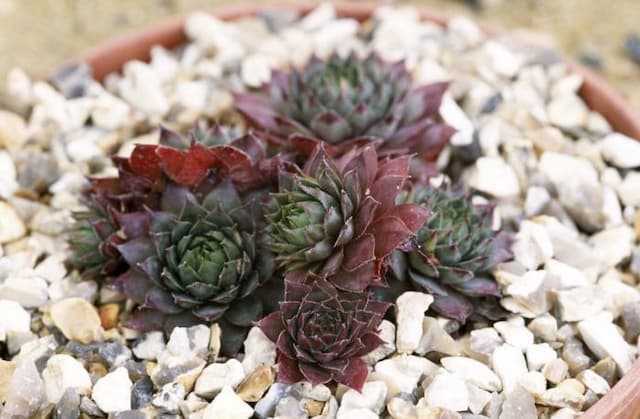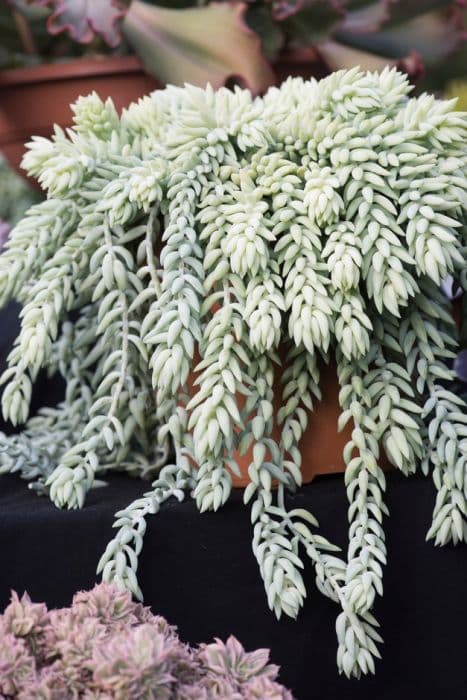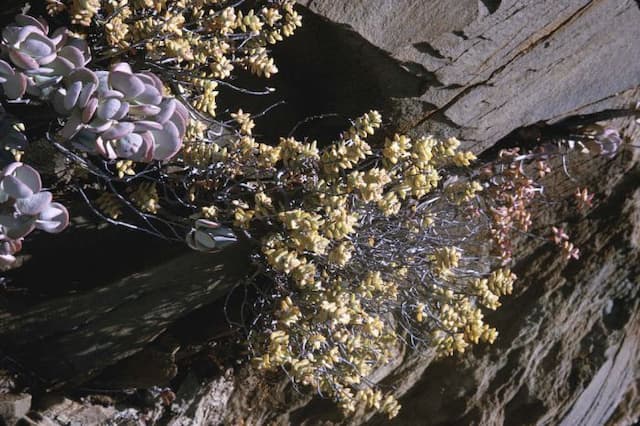Lipstick Echeveria Echeveria agavoides











ABOUT
Echeveria agavoides, commonly known as the Lipstick Echeveria, is a succulent plant that is admired for its distinctive and ornamental appearance. This plant has a rosette growth pattern, where the leaves are arranged in a circular pattern that resembles a flower. Each leaf is thick and fleshy, a characteristic typical of plants that store water to survive dry conditions. The leaves are pointed, resembling an agave, which is where its name 'agavoides' originates from. The Lipstick Echeveria has a glossy green coloration that can be so bright as to almost seem translucent under certain lighting conditions. The edges of the leaves are often highlighted with a red or pinkish hue, giving it the appearance of having been dipped in lipstick, hence its common name. The vibrant edge coloration becomes more pronounced when the plant is exposed to sunlight or during particular growth phases. Textured with subtle lines running from the base to the tip, the leaves of the Lipstick Echeveria have a waxy or slightly powdery coating. The overall visual effect of the plant is one of symmetry and compactness, presenting a well-defined and attractive form that makes it a favorite for succulent collections and as a decorative houseplant.
About this plant
 Names
NamesFamily
Crassulaceae.
Synonyms
Molded Wax Agave, Agave Echeveria, Wax Agave, Carpet Echeveria.
Common names
Echeveria agavoides.
 Toxicity
ToxicityTo humans
Echeveria agavoides, commonly known as "Lipstick Echeveria", is generally considered non-toxic to humans. Ingesting parts of the plant typically does not result in poisoning or adverse symptoms.
To pets
Lipstick Echeveria is also non-toxic to pets. It is not known to cause poisoning if pets ingest parts of the plant. However, it is always a good practice to prevent pets from eating plants as a precautionary measure.
 Characteristics
CharacteristicsLife cycle
Perennials
Foliage type
Evergreen
Color of leaves
Green
Flower color
Red
Height
0.5 feet (15 cm)
Spread
0.5 feet (15 cm)
Plant type
Succulent
Hardiness zones
9
Native area
Mexico
Benefits
 General Benefits
General Benefits- Low Maintenance: Echeveria agavoides, commonly known as Lipstick Echeveria, requires minimal care, which is great for busy plant owners or beginners.
- Drought Tolerant: Adapted to dry conditions, this plant can withstand periods without water, making it ideal for water conservation in arid climates.
- Decorative: With its attractive, rosette-shaped form and red-tipped leaves, it adds aesthetic appeal to any space.
- Easy Propagation: Lipstick Echeveria can be easily propagated from leaves or offsets, allowing gardeners to expand their collection or share with friends.
- Compact Size: It stays relatively small, so it's well-suited to indoor spaces like windowsills and desktops or in small gardens.
- Pest Resistant: Generally resistant to pests, reducing the need for chemical treatments and maintenance.
- Long Living: As a succulent, it has a long lifespan, providing years of enjoyment with proper care.
- Seasonal Interest: Produces beautiful inflorescences that add a pop of color and interest, typically in the spring or early summer.
 Medical Properties
Medical PropertiesThis plant is not used for medical purposes.
 Air-purifying Qualities
Air-purifying QualitiesThis plant is not specifically known for air purifying qualities.
 Other Uses
Other Uses- Echeveria agavoides, commonly known as the 'Lipstick Echeveria,' can be utilized as part of a green roofing system, helping to insulate buildings and provide an attractive aesthetic.
- The rosettes of the Lipstick Echeveria can be crafted into living jewelry, such as pendants and brooches, offering a unique botanical accessory for enthusiasts.
- When integrated into miniature gardens or fairy gardens, the Lipstick Echeveria serves as an excellent mimic for larger tree-like plants due to its rosette shape and structure.
- The Lipstick Echeveria can be a source of inspiration for artists and designers, featuring prominently in drawings, paintings, and textile patterns due to its geometric form.
- Using the Lipstick Echeveria as a natural dye, the pigments extracted from its leaves can tint textiles and crafts with a subtle range of green shades.
- In photography, the Lipstick Echeveria is often showcased in plant still-life compositions due to its striking form and vibrant colors, contributing to its popularity on social media platforms.
- This plant is sometimes used in educational settings to teach children about plant care and the water-storing adaptations of succulents.
- During ceremonial events or gatherings, the Lipstick Echeveria can be utilized in table arrangements, as its low water requirements and robust nature make it an ideal decorative element.
- The Lipstick Echeveria's ability to propagate easily from leaf cuttings makes it a favorite amongst plant enthusiasts for plant swapping, fostering a sense of community and sharing.
- Some culinary experiences use the rosette patterns of the Lipstick Echeveria as inspiration for plate decoration or food presentation, although the plant itself is not edible.
Interesting Facts
 Feng Shui
Feng ShuiThe Echeveria agavoides, commonly known as the lipstick echeveria, is not used in Feng Shui practice.
 Zodiac Sign Compitability
Zodiac Sign CompitabilityThe lipstick echeveria is not used in astrology practice.
 Plant Symbolism
Plant Symbolism- Perseverance: Echeveria agavoides, commonly known as the Wax Agave, is a succulent that thrives in harsh, dry environments. Its ability to store water in its leaves symbolizes the trait of perseverance and endurance through difficult times.
- Self-reliance: The Wax Agave is adept at conserving water and nutrients, symbolizing the quality of self-reliance and independence, an inspirational reminder of our ability to sustain ourselves emotionally and physically.
- Beauty and Balance: With its symmetrical rosette pattern and attractive foliage, the Wax Agave represents beauty, reflecting an aesthetic balance in nature that can inspire us to seek harmony in our own lives.
- Adaptability: The Wax Agave's capacity to adapt to diverse growing conditions makes it a symbol of adaptability, encouraging flexibility and the ability to thrive in a variety of life's circumstances.
- Protection: The pointed tips of the Wax Agave leaves can serve to deter predators, symbolically representing protection and a reminder to safeguard ourselves and our loved ones from life's metaphorical threats.
 Water
WaterThe Echeveria agavoides, commonly known as the Lipstick Echeveria, prefers thorough watering when the soil has completely dried out. Typically, this means watering every two to three weeks, but the schedule may vary depending on the climate and environment. When watering, it is crucial to provide enough water to soak the soil thoroughly until water runs out of the drainage holes of the container. This might be approximately 8-12 ounces for a small to medium-sized pot every few weeks. Avoid letting the plant sit in water, as this can lead to root rot.
 Light
LightLipstick Echeveria thrives best in bright, indirect sunlight for the majority of the day with some exposure to direct sun. The ideal spot would be a south or east-facing window, where it gets four to six hours of sunlight each day. They can tolerate direct sunlight, but too much can cause their leaves to sunburn.
 Temperature
TemperatureLipstick Echeveria prefers temperatures between 65°F and 80°F, which are typical for most indoor environments. They can withstand a drop to about 40°F but should not be exposed to temperatures below freezing as this can cause damage to the plant.
 Pruning
PruningLipstick Echeveria requires minimal pruning, which is mostly done to remove dead leaves or spent flower stalks. This helps prevent rot and maintain the plant's appearance. The best time for pruning is during the active growing season in spring and summer. Dead leaves should be gently pulled away or carefully cut off with clean scissors.
 Cleaning
CleaningAs needed
 Soil
SoilThe best soil mix for the Echeveria agavoides, commonly known as the "Molded Wax Agave," is a well-draining cactus or succulent mix with added perlite or pumice for aeration. A pH level of around 6.0 is ideal for this plant, slightly acidic to neutral. You can make your own mix by combining equal parts of potting soil, coarse sand, and perlite or pumice.
 Repotting
RepottingMolded Wax Agave should be repotted every two to three years or when it outgrows its current container. It's best to repot in the spring or early summer, which is the beginning of its active growing season.
 Humidity & Misting
Humidity & MistingMolded Wax Agave prefers low to average humidity levels, typical of indoor environments. It does not require high humidity and can thrive in the dry conditions often found in homes or offices.
 Suitable locations
Suitable locationsIndoor
Place in bright, indirect light and rotate periodically for even growth.
Outdoor
Grow in partial sun to light shade; protect from harsh midday sun.
Hardiness zone
9-11 USDA.
 Life cycle
Life cycleEcheveria agavoides, commonly known as Lipstick Echeveria, begins its life as a seed, which under the right conditions of warmth and moisture, germinates into a small seedling. The seedling gradually develops rosettes of waxy, succulent leaves with pointed tips, typical of the agavoides variety, often exhibiting a reddish tinge along the edges when exposed to sufficient light. As the plant matures, it reaches its vegetative stage, during which it grows larger and may produce offsets, or "pups," around its base, allowing for vegetative propagation. Throughout its life, given proper care with minimal water and good sunlight, the Lipstick Echeveria will enter its blooming stage periodically, usually in the warmer months, producing attractive, erect flowering stalks with bell-shaped flowers in shades of red, pink, or yellow. After several years, when the plant has reached the end of its lifespan, it will begin to deteriorate and die, but often not before leaving behind several offspring that carry on its genetic lineage. The exact duration of its life cycle can vary widely depending on environmental conditions and care practices.
 Propogation
PropogationPropogation time
Spring-Summer
Echeveria agavoides, commonly known as the Lipstick Echeveria, is most successfully propagated during the spring or early summer, when it's actively growing. The most popular method of propagation for this plant is through leaf cuttings. To propagate, gently twist a healthy leaf from the stem, ensuring that the entire base of the leaf is intact. After removing the leaf, it should be left to callous over for a few days to prevent rot when planted. Once the cut end has dried, place the leaf on top of well-draining soil, avoiding direct sunlight. In a few weeks, new roots and a small rosette will begin to develop at the base of the leaf. It is important to keep the soil slightly moist but never waterlogged to encourage growth. Once the new plant is established, it can be transplanted into its own pot.









